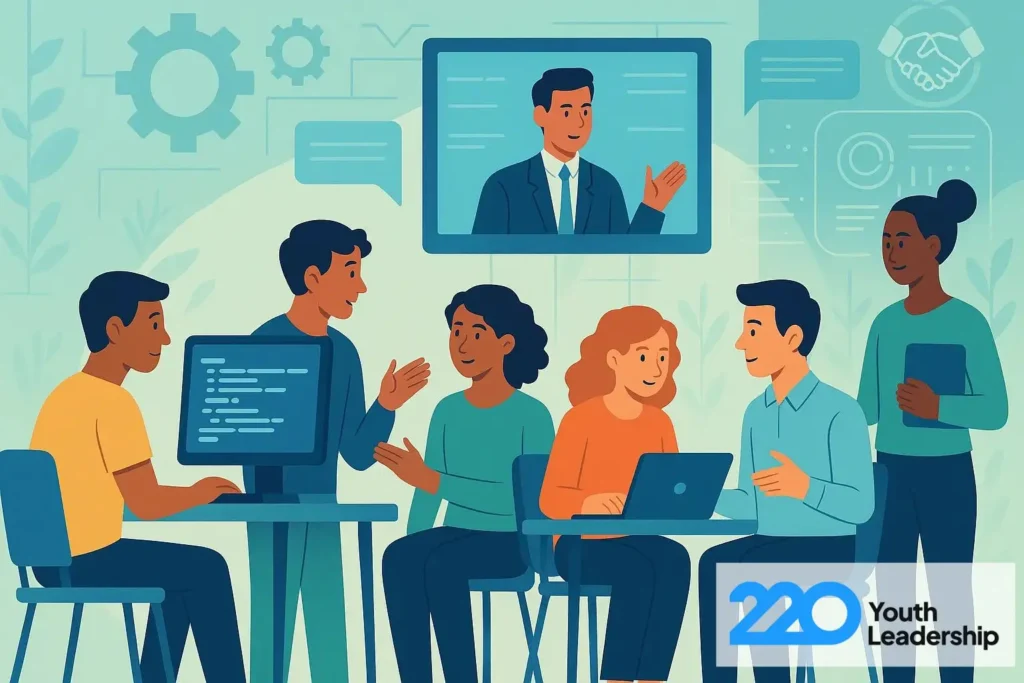
What is workforce development and why should anyone care about it? Simply put, it is about equipping people with the skills and know-how to standout in today’s job market.
Not only that. It’s a game-changer for building careers, boosting local economies, and preparing young people for future success.
Get ready as we break down its key components, benefits, and strategies in this guide.
Key Takeaways
Workforce development is a comprehensive approach focused on enhancing individual skills and knowledge to meet labor market demands through training, education, and support services.
Effective workforce development programs rely on evidence-based practices, public-private partnerships, and diversified funding to ensure relevance and sustainability.
Integrating workforce development principles into K-12 education prepares students for future careers by emphasizing critical skills, personalized experiences, and strong industry partnerships.
Understanding Workforce Development
As rightly mentioned in the introduction, workforce development is about giving people, especially young job seekers, the tools to succeed in a fast-changing labor market. Think of it as a bridge connecting your skills to the jobs of tomorrow.
Workforce development focuses on building a skilled workforce through training programs, career counseling, and support services, helping everyone from high school students to incumbent workers stay competitive.
It doesn't just stop there. It’s also about creating opportunities for career advancement and economic security.
For young people, programs like 220 Youth Leadership show how it’s done, blending technical know-how with leadership skills to prepare youths for the future.
Core Components of Workforce Development Programs
Great workforce development programs are like a well-built house, needing a strong foundation. That foundation includes three key pillars: training and education, employment services, and support services.
Each plays an important role in preparing job seekers, especially youths, for the demands of today’s industries.
Let's look at them in more details:
Training and Education
Training programs are the backbone of workforce development. They equip job seekers with the skills needed to be relevant in the labor market. From technical education in fields like cybersecurity to on-the-job training, these programs are designed to be practical and useful.
Here’s where it gets exciting: modern workforce development uses online platforms, virtual coaching, and partnerships with community colleges to make training accessible and tailored to individual needs.
For young people, this means hands-on opportunities like apprenticeship programs or career pathways that start in high school. As an example, a student learning coding through a local tech company partnership is the kind of real-world prep we’re talking about.
These initiatives prioritize:
Lifelong learning to keep skills fresh,
Technology integration for digital fluency,
Personalized learning to match career goals,
Leadership skills like communication and teamwork.
All of these elements are not to be overlooked if youths will navigate the global economy and lead in their chosen fields successfully.
Employment Services
The next on the list is employment services that connect job seekers with employers. They include job fairs, resume workshops, or American Job Centers that act as matchmakers for the workforce.
Local workforce development boards play a huge role here, linking job seekers with businesses that need their skills. Under the Workforce Innovation and Opportunity Act, these services help unemployed workers and dislocated worker programs get back on their feet.
For young people, employment services can open doors to internships or entry-level roles that build confidence and skills.
Employer partnerships ensure these programs stay relevant, increasing employment rates and economic security.
Support Services
Support services are the glue that holds it all together. They help job seekers overcome barriers, like lack of transportation or confidence. Career counseling, for instance, guides youth through career pathways, while social services address personal challenges.
Intensive services like mentorship or follow-up support are key for young people, building the leadership and resilience needed to succeed.
Why does this matter? Because a supported job seeker is a successful one. How? By offering core services like resume help or interview coaching, workforce development programs ensure everyone, including disadvantaged workers, has a fair shot at success.
Effective Implementation Strategies
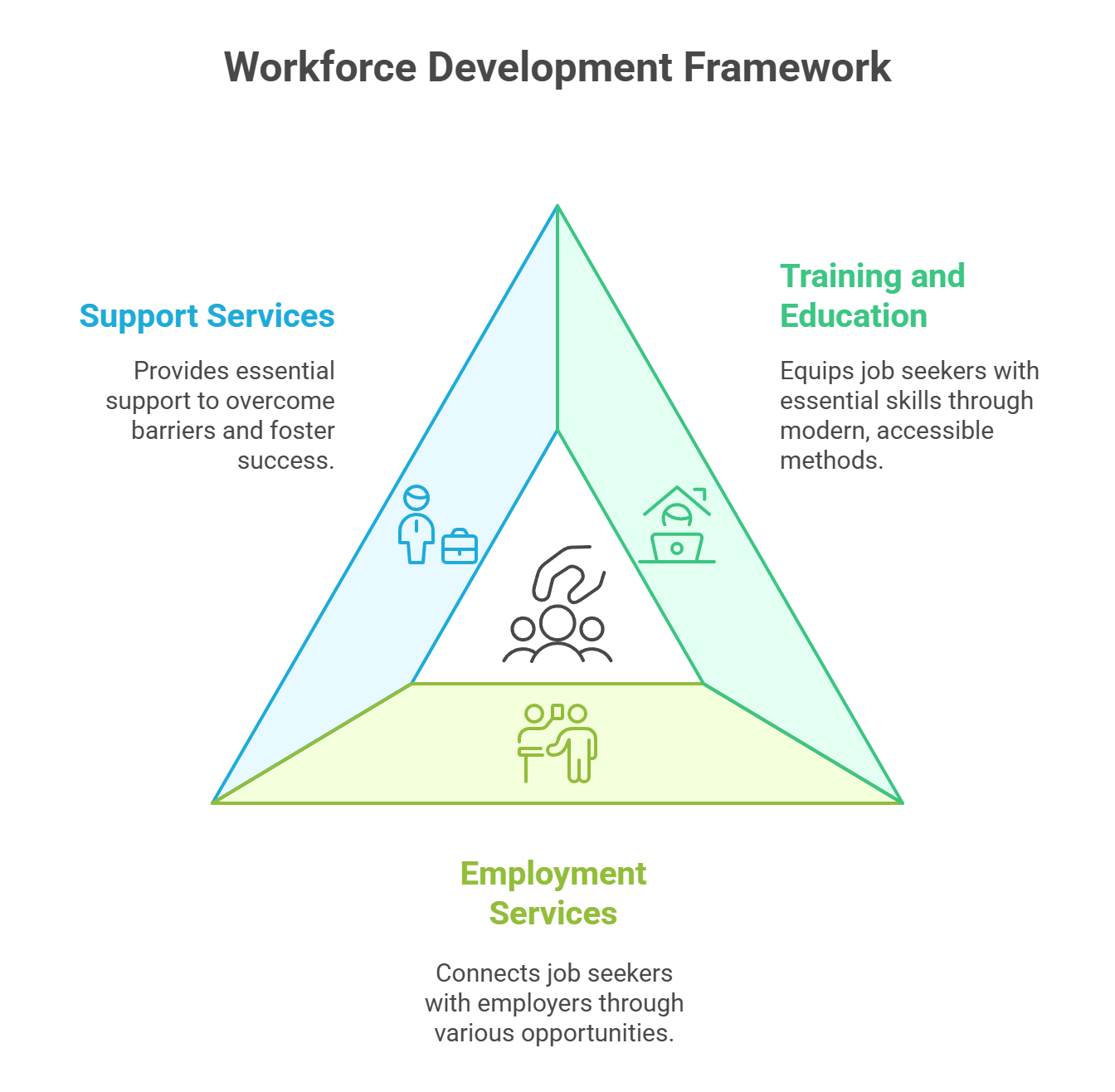
Building a workforce development system that works takes smart strategies. These are the engines that keep programs relevant and sustainable. The three ‘big’ ones are:
Evidence-Based Practices
Great programs don’t dabble into guesswork. Instead, they use proven methods. Here are four core practices that make workforce development effective:
Sequenced: Training is structured in a logical order, building skills step by step.
Active: Participants experience hands-on learning, like role-playing leadership scenarios.
Focused: Programs zero in on specific skills, like problem-solving or technical know-how.
Explicit: Clear goals and instructions make it easy for learners to succeed.
These practices ensure training programs meet the labor market’s needs while helping youths develop leadership skills they can apply in any career.
Public-Private Partnerships
Another strategy that cannot be overlooked is collaboration. When local governments, government agencies, and private employers team up, workforce development programs are sure to hit the mark.
These partnerships align training with what industries need, ensuring job seekers are ready for real jobs. For example, a tech company might work with a program to offer coding bootcamps, giving students a head start.
Strong partnerships also boost economic development by creating a viable workforce that attracts businesses to local areas; a win-win for everyone.
Diversified Funding
Money matters, and great programs need steady funding to keep things moving. Resources like government grants, private investments, employer contributions, and participant fees, should be considered, for workforce development to stay sustainable.
This mix helps programs weather budget cuts and keep serving job seekers, from low-skilled workers to youths in adult education programs.
Current Trends in Workforce Development
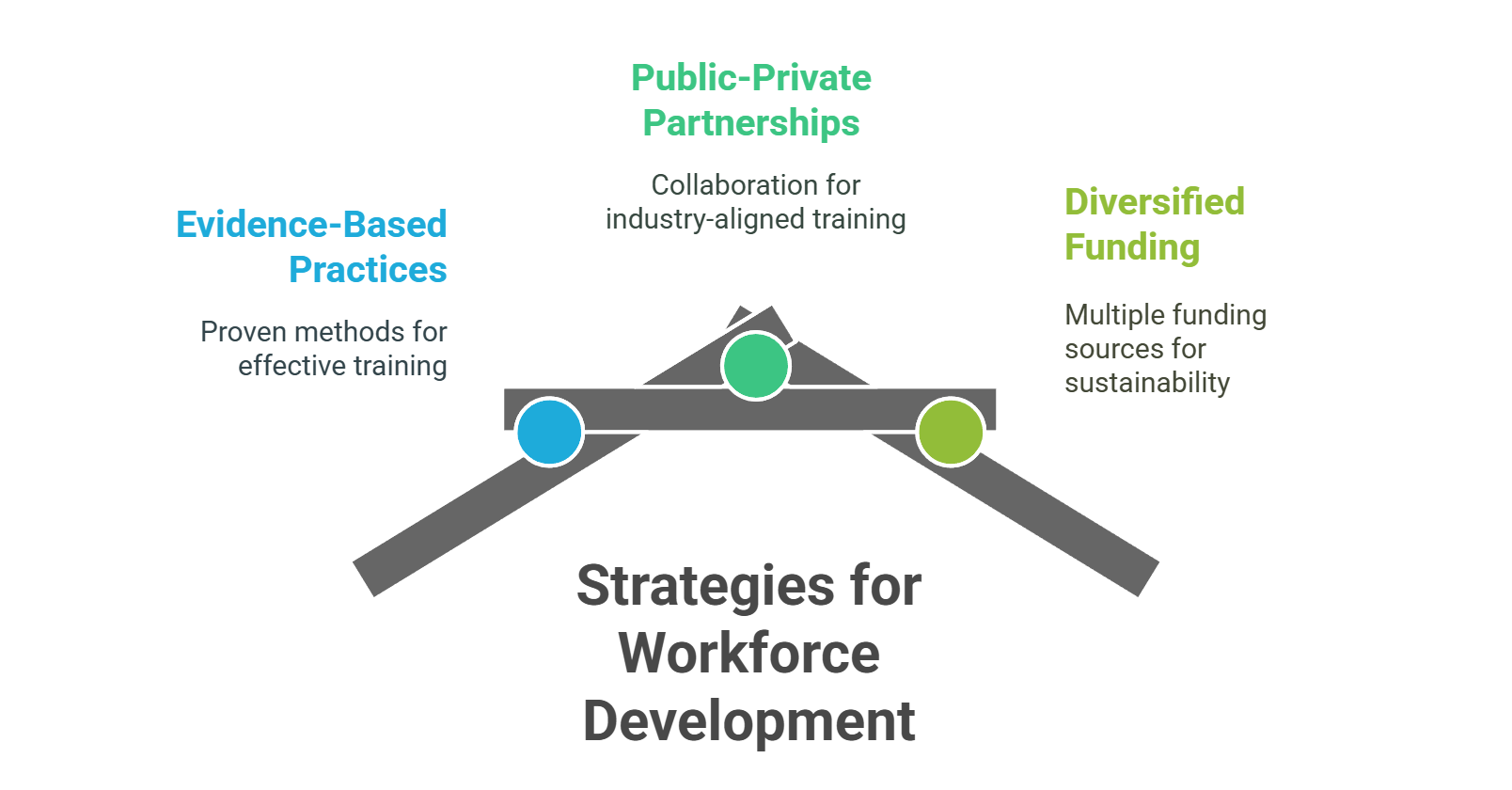
The labor market doesn’t stand still, and neither does workforce development. For young people who look forward to stepping into leadership roles, these three trends are the pacesetters of the future:
Technological Integration
Tech is changing how we work, and workforce development is keeping up. Training programs now use virtual reality, AI tools, and online platforms to teach skills.
With 87% of companies worldwide facing skills gaps, or expecting to face them soon, according to recent industry reports, programs are prioritizing tech literacy.
For young people, this means learning to use tools like data analytics software or collaboration platforms, all of which are essential skills that make them stand out as leaders.
Personalized Learning Experiences
A one-size-fits-all approach doesn't cut it anymore. Today’s workforce development focuses on tailoring education to individual goals.
For a high school student, this might mean a career pathway plan that mixes coding classes with teamwork workshops.
There's more: personalized learning keeps job seekers engaged and ensures they gain skills that match their dreams.
Emphasis on Soft Skills
Automation is taking over routine tasks, so employers are hungry for soft skills like communication, teamwork, leadership, adaptability and time management.
Workforce development programs are stepping up, teaching youth how to lead projects or collaborate effectively. These skills are gold for young people, helping them excel in any workplace.
Benefits and Measurable Outcomes
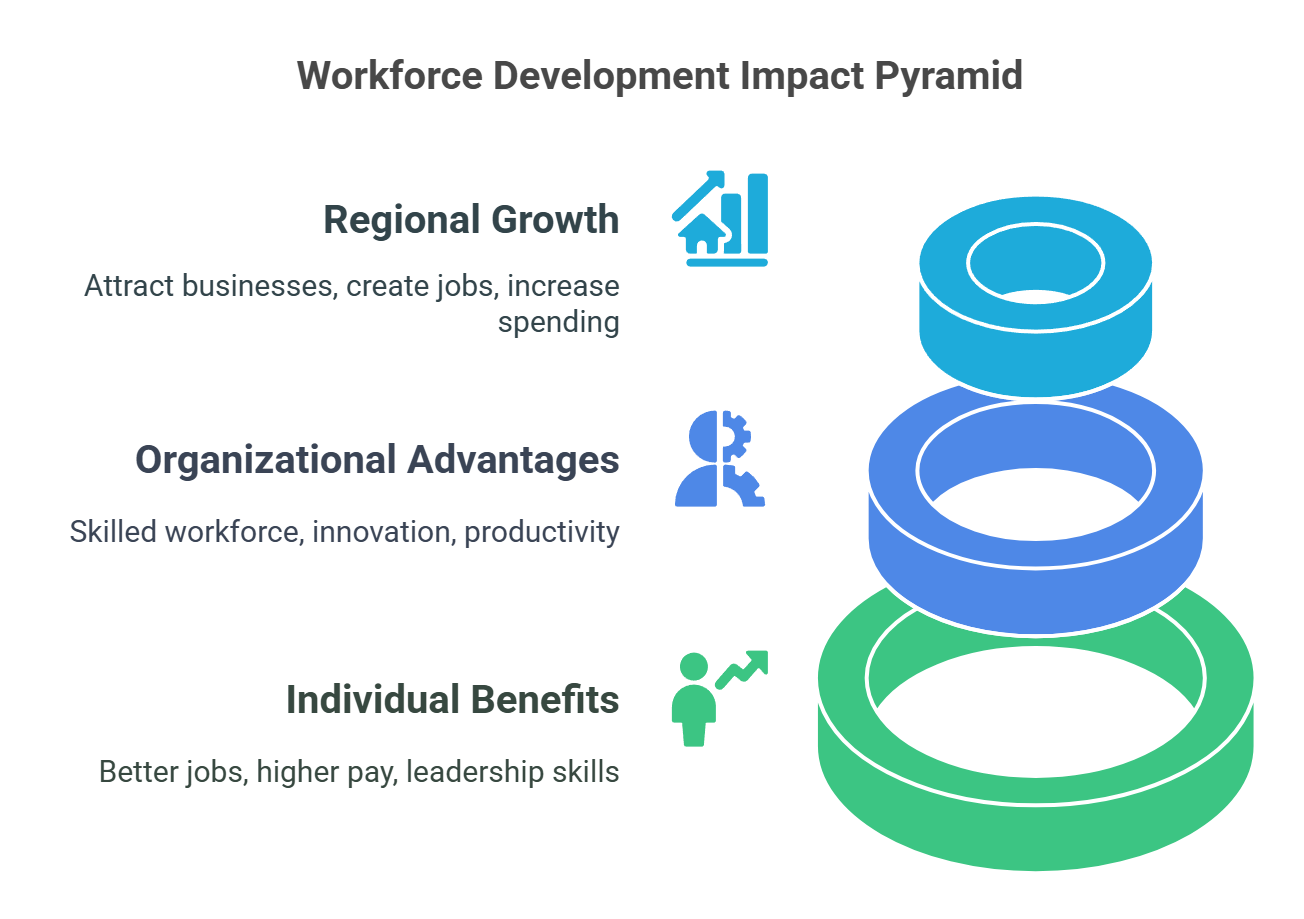
Workforce development isn’t just talk, it delivers real-time results.
Here’s how it impacts individuals, organizations, and regional economies:
For Individuals
For job seekers, workforce development opens doors to better jobs and higher pay. By building skills training in high-demand fields, these programs boost career advancement opportunities.
Youth gain leadership skills that make them confident and competitive, ready to tackle the labor market with fewer opportunities for failure.
For Organizations
Show me a company that doesn’t love a skilled workforce, and I’ll show you a business missing out on its greatest asset. These training programs don’t just tick the boxes. They are responsible for employee satisfaction, slashing turnover rates, and promoting a culture of innovation.
When employees, especially young and ambitious talent, gain new skills, they inject fresh perspectives and creative energy into the organization.
The result? Improved productivity and a team hungry for growth and development.
For Regional Economies
A skilled workforce is often the cheat code for economic growth. Regions with strong workforce development attract businesses, create jobs, and increase consumer spending. By preparing youth and incumbent workers for in-demand roles, programs support economic developers and build forward communities.
Challenges and Solutions in Workforce Development
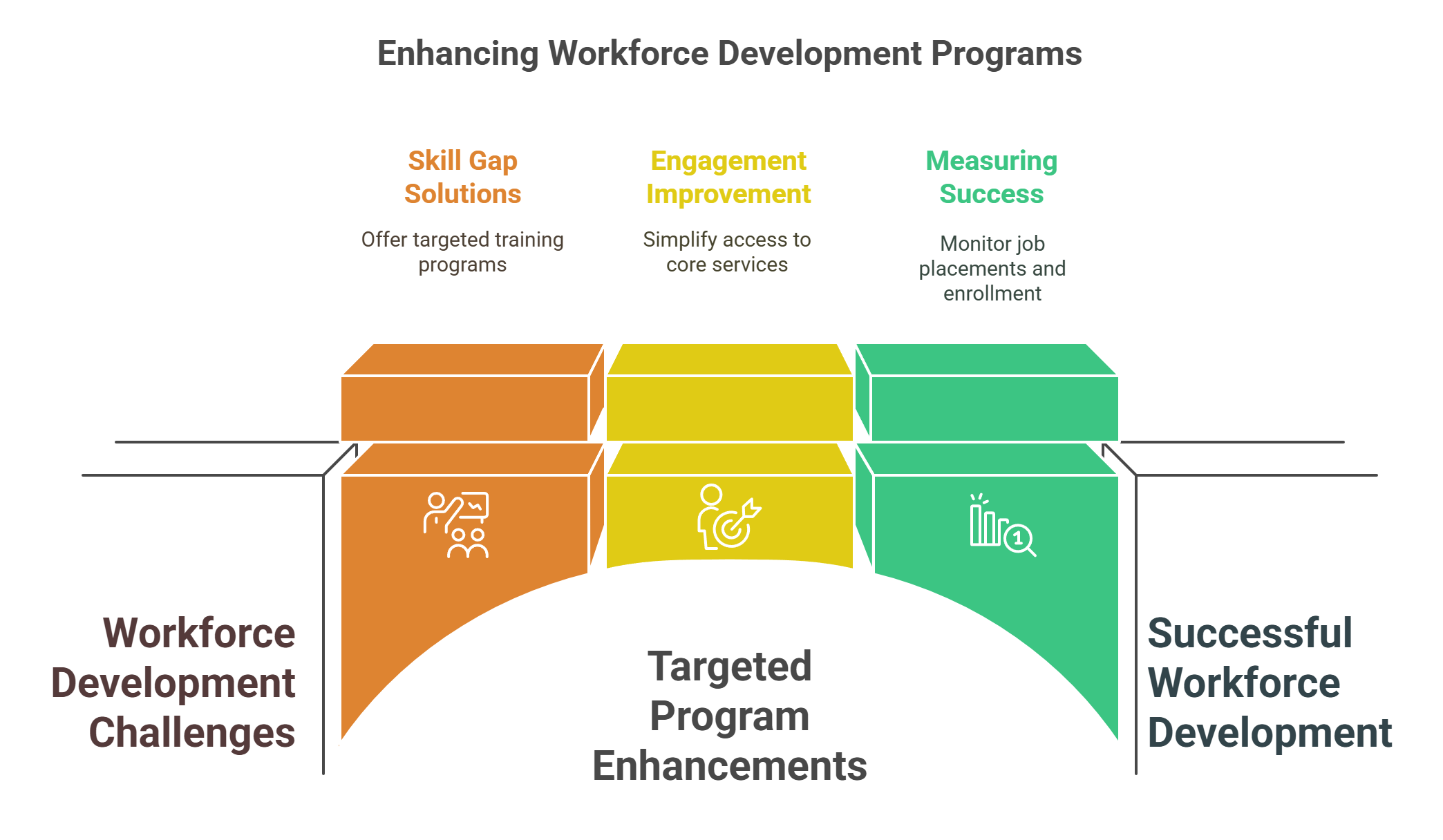
No program is perfect and workforce development programs are not left out. This section explores some of the common challenges these programs are faced with and their solutions too.
Skill Gaps
The skills gap is real, with rapid tech changes and an aging workforce, which means that job seekers need constant upskilling. If not managed properly, Korn Ferry notes that this could lead to over 85 million jobs going unfilled, resulting in an annual loss of $8.5 trillion annually.
Workforce development bridges this gap with targeted training programs, like registered apprenticeship programs for youth. Encouraging talent mobility, where employees share skills across teams, also helps close these gaps.
Engagement and Retention
Keeping job seekers engaged is tough, especially youths juggling school and life. Programs that offer mentorship, career counseling, or interactive workshops increase morale and retention rates.
Therefore, simplifying access to core services, like job search tools, can keep participants motivated.
Measuring Success
How do you know a program is truly effective? Key performance indicators (KPIs) such as career readiness, entrepreneurial skills, leadership and financial literacy can help measure success.
Additionally, monitoring job placements, enrollment in further education, and growth in leadership confidence provides deeper insight into a program’s impact.
Through careful data analysis of these metrics, the program can continuously refine its approach, ensuring it meets the unique needs of young people and empowers them to succeed.
Implications for K-12 Education
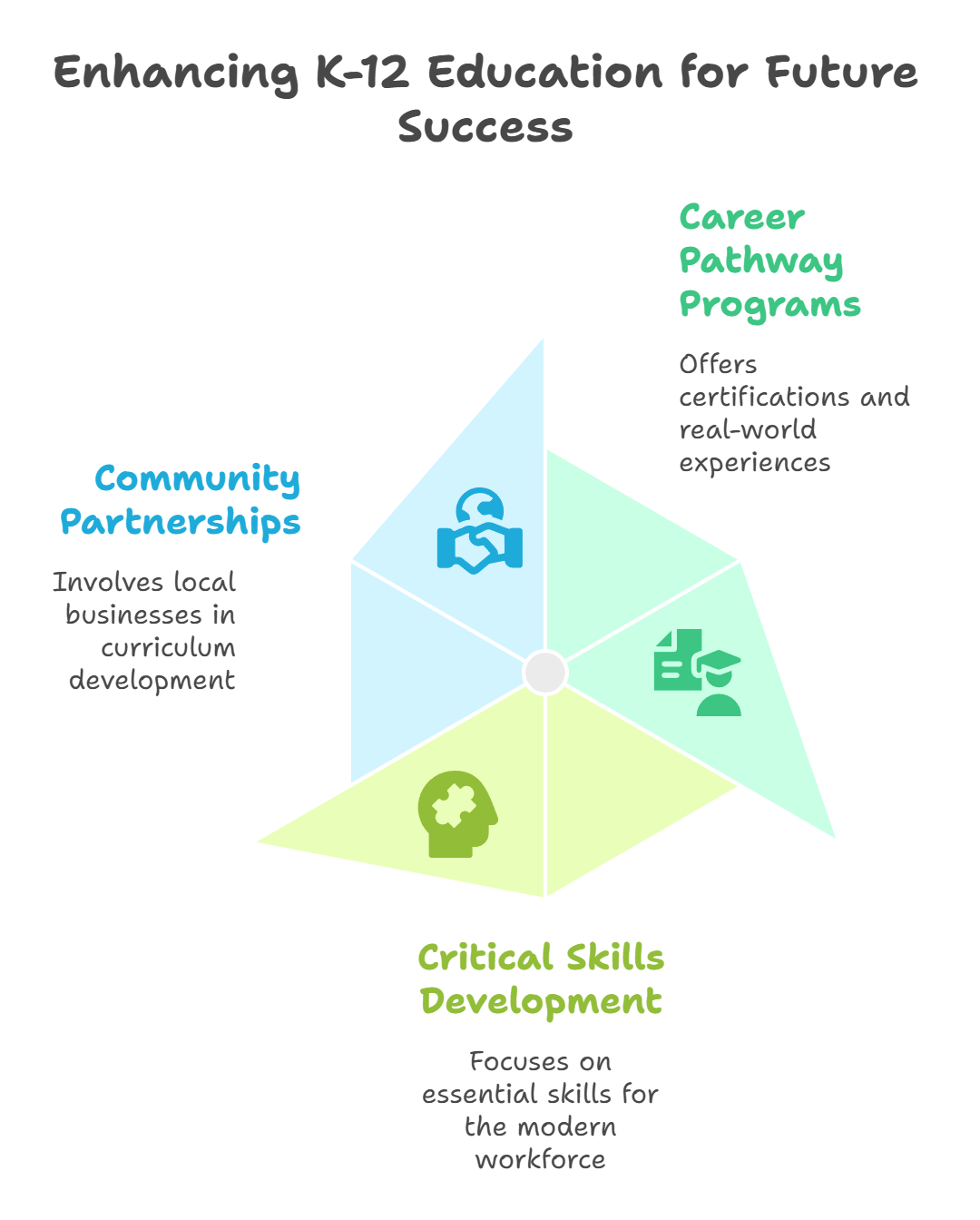
Want to prepare students for the future? Start early. Integrating workforce development into K-12 education sets young people up for success by building critical skills and career pathways.
Here is how:
Career Pathway Programs
Career pathways let high school students earn certifications in fields like IT or healthcare while developing leadership skills. Plus, partnerships with local businesses offer internships or job shadowing, giving students a taste of real-world careers. These programs prepare students for postsecondary education and beyond.
Critical Skills Development
Schools should teach more than academics. That's where skills like critical thinking, communication, adaptability, and technology literacy come in. They are must-haves for the modern labor market. By embedding these into the curriculum, educators help youth become confident leaders ready to tackle job opportunities.
Community Partnerships
Local businesses and community-based organizations are key partners. They help schools create curricula that match industry needs, making sure students learn relevant skills.
For example, a tech firm might partner with a school to teach coding and leadership, driving economic development at the community level.
Strategic Recommendations for Educators
Educators are the unsung heroes of workforce development. Here’s how they can prepare students for careers and leadership.
Integrate Workforce Development Principles
Educators can blend skills like problem-solving and teamwork alongside traditional academics. By weaving workforce development into lessons, educators can prepare students to enter the labor market confidently. Lastly, programs combining technical education with leadership training create well-rounded graduates.
Foster Industry Collaborations
To stay ahead of the curve, educators can also work with businesses to create industry-driven education. These partnerships give students hands-on experience, like leading a project or interning at a local company. They also keep curricula fresh and relevant, ensuring youths are ready for specific industry demands.
Continuous Professional Development
Educators need to stay sharp, too. Ongoing training helps them understand workforce trends and equips them to teach skills like digital literacy or leadership. This ensures they can guide students toward successful careers.
Supporting Diverse Youth
Workforce development must include everyone, especially disadvantaged workers like low-income or minority youth. Programs should offer tailored support, like scholarships for training or mentorship for leadership roles.
The 220 Youth Leadership program, for instance, prioritizes outreach to underserved communities, ensuring all youth have access to career pathways and leadership opportunities.
Summary
One thing is certain: workforce development is a powerful tool for building a skilled workforce that drives economic growth and career development.
By combining training programs, employment services, and support services, job seekers are prepared for success in the labor market. Trends like technology integration and soft skills training keep programs relevant, while strategies like public-private partnerships ensure sustainability.
By integrating these principles into K-12 education, we’re building a future where every job seeker is positioned for growth.
At 220, our mission is to help young people unlock their potential with essential skills needed for success in life and work regardless of their starting point. Want to join the moving train?
Frequently Asked Questions
What is workforce development?
Workforce development is essential for equipping individuals with the necessary skills and knowledge to adapt to changing labor market demands, ultimately improving economic stability in the region. It also focuses on enhancing workforce capabilities to support both individual growth and community prosperity.
What are the core components of workforce development programs?
The core components of workforce development programs are training and education, employment services, and support services. These elements are essential for equipping individuals with the skills and resources needed to succeed in the job market.
Why are public-private partnerships important in workforce development?
Public-private partnerships are fundamental in workforce development as they align training programs with the specific needs of industries, advancing the effectiveness and relevance of the workforce. This collaboration ultimately leads to a more skilled and adaptable labor force, benefiting both individuals and employers.
How do workforce development programs benefit individuals?
Workforce development programs benefit individuals by equipping them with in-demand skills, promoting career advancement opportunities, and increasing their earning potential. This in turn leads to greater job security and satisfaction.
What role do educators play in workforce development?
Educators play a pivotal role in workforce development by integrating relevant skills into their curricula and improving partnerships with industry to prepare students for successful careers. This approach ensures that education remains aligned with the evolving demands of the job market.
